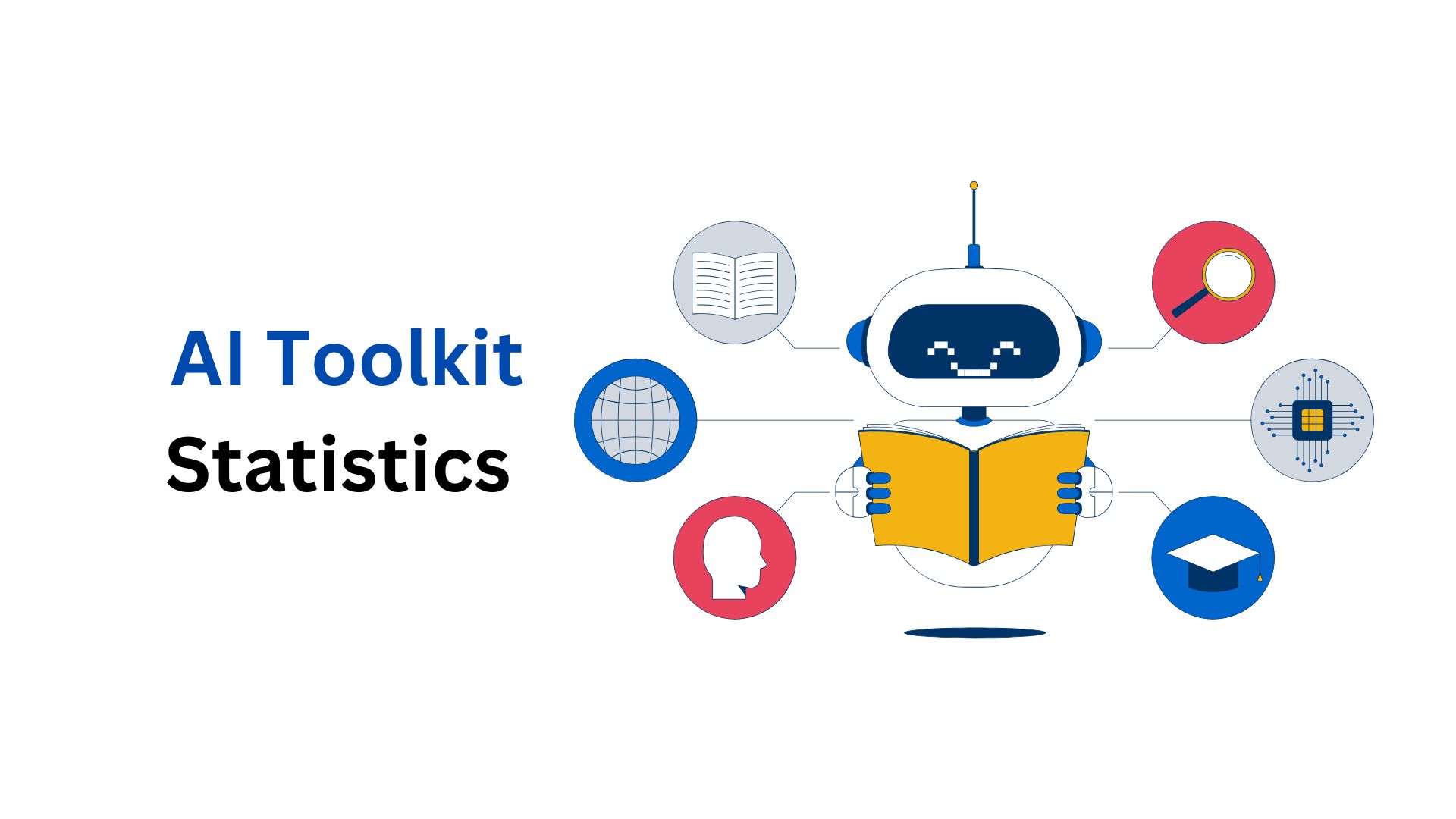VoIP Statistics By Market, User, Region, Usage, Security And Compliance (2025)
Updated · Nov 28, 2025

Table of Contents
- Introduction
- Editor’s Choice
- Top Features of VoIP
- General VoIP Statistics
- VoIP Market Statistics
- VoIP User Statistics
- Mobile VoIP Market Statistics by Region
- VoIP Calls Statistics by Type
- VoIP Usage Statistics
- VoIP Statistics by Cost, Features, and Customer Experience
- VoIP Business Adoption Statistics
- VoIP Security and Compliance Statistics
- VoIP Website Traffic Statistics
- Top 10 VoIP Service Providers Statistics, 2025
- Pros and Cons of VoIP
- Conclusion
Introduction
VoIP Statistics: Voice over Internet Protocol (VoIP) means using the Internet to make phone calls. Instead of using traditional telephone lines, VoIP lets voice messages travel over the Internet. VoIP became popular in the 1990s and started growing quickly around the year 2005.
Now, with VoIP, voice travels through the internet in small data packets instead of using a separate phone connection. It works by turning the user’s voice into digital signals and sending them like emails or videos do. VoIP has become popular because it’s cheaper, flexible, and works from anywhere.
This article includes several current analyses of VoIP’s features, overall market growth, implementations, usages, and other factors, which are taken from different insights.
Editor’s Choice
- Precedence Research depicts that by the end of 2025, the VoIP market will reach around USD 161.79 billion and is estimated to grow to USD 415.20 billion by 2034.
- In 2024, North America led the VoIP industry, earning 48% of total revenue.
- According to the Wifi Talents report, the adoption rate of AI-powered VoIP solutions is expected to grow by 20% annually through 2025, due to advancements in AI technology.
- By 2025, more than 30% of business communication will happen through VoIP and unified communication tools.
- The number of devices that support VoIP is also expected to cross 2 billion.
- Energy use in VoIP data centres is likely to drop by 10% by 2024.
- The VoIP endpoint market may grow steadily at 7.8% yearly, reaching USD 15 billion by 2030.
- Meanwhile, the VoIP encryption market could reach USD 2 billion.
- According to market.us, the number of mobile VoIP users is projected to reach 3.6 billion by 2026, and fixed VoIP subscribers worldwide have reached 204 million in 2024.
- A report published by sci-tech-today.com states that in 2024, more than 3 billion people were using VoIP globally.
Top Features of VoIP
- Voice Calls
- Caller ID
- Call Forwarding
- Call Transfer
- Call Routing
- Three-way Calling
- Conference Calling
- Call Park
- Auto-attendants
- IVR
- Call Queues
- Custom Music on Hold
- Voicemail
- Voicemail Transcription
- Video Conferencing
- Instant Messaging
- Business Text Messaging
- Online Faxing
- Call Recording
- Call Analytics
- Call Screening
- Anonymous Call Rejection
- DND (Do Not Disturb)
- Number Porting
- Hot Desking
- Mobile App
- Unified Communications
- CRM integrations
- Business Phone Numbers
General VoIP Statistics
- According to Nextiva reports, by 2032, the VoIP Service market is expected to reach around USD 108.5 billion.
- It is also expected that by 2031, the global mobile VoIP will grow to USD 327.5 billion.
- The usage share of different types of voice services is VoIP (36%), POTS (24%), PRI (11%), and Cellular (8%).
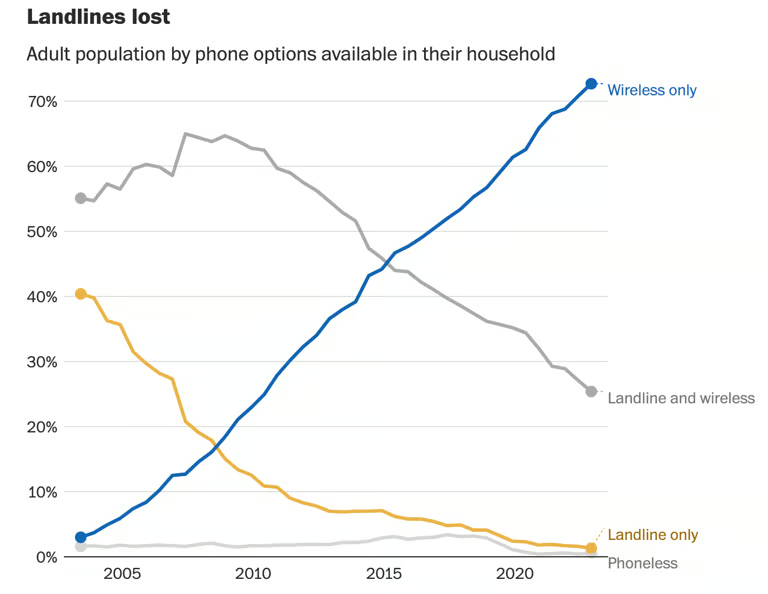
- As of 2022, about 70% of adults in the U.S. and 83% of kids live in homes that don’t have a landline phone.
- VoIP statistics show that global companies can cut phone bills by as much as 50%, while small businesses may lower startup costs by nearly 90%.
- However, VoIP prices might rise by around 3% in the next five years.
- Also, 62% of contact centres use IVR systems, and 59% of workers still rely on desk phones daily.
- The Acetone report further states that after using VoIP, small businesses save 40% on local, 90% on international calls, and save 30% on teleconferencing.
- Companies using VoIP have noticed their productivity goes up by 20%.
- According to NUACOM reports, a business with 30 VoIP phone users can save around USD 1,200 each month.
- About 47% of businesses already use VoIP to send SMS messages, while 74% of employees use a mobile app for making work calls through VoIP.
- On average, an employee spends about 400 minutes each month on VoIP calls.
- According to market.us, the number of mobile VoIP users is projected to reach 3.6 billion by 2026, and fixed VoIP subscribers worldwide have reached 204 million in 2024.
- As of 2024, nearly 93% of companies using VoIP said work improved; 67% rely on it, saving 32 minutes per worker daily.
VoIP Market Statistics
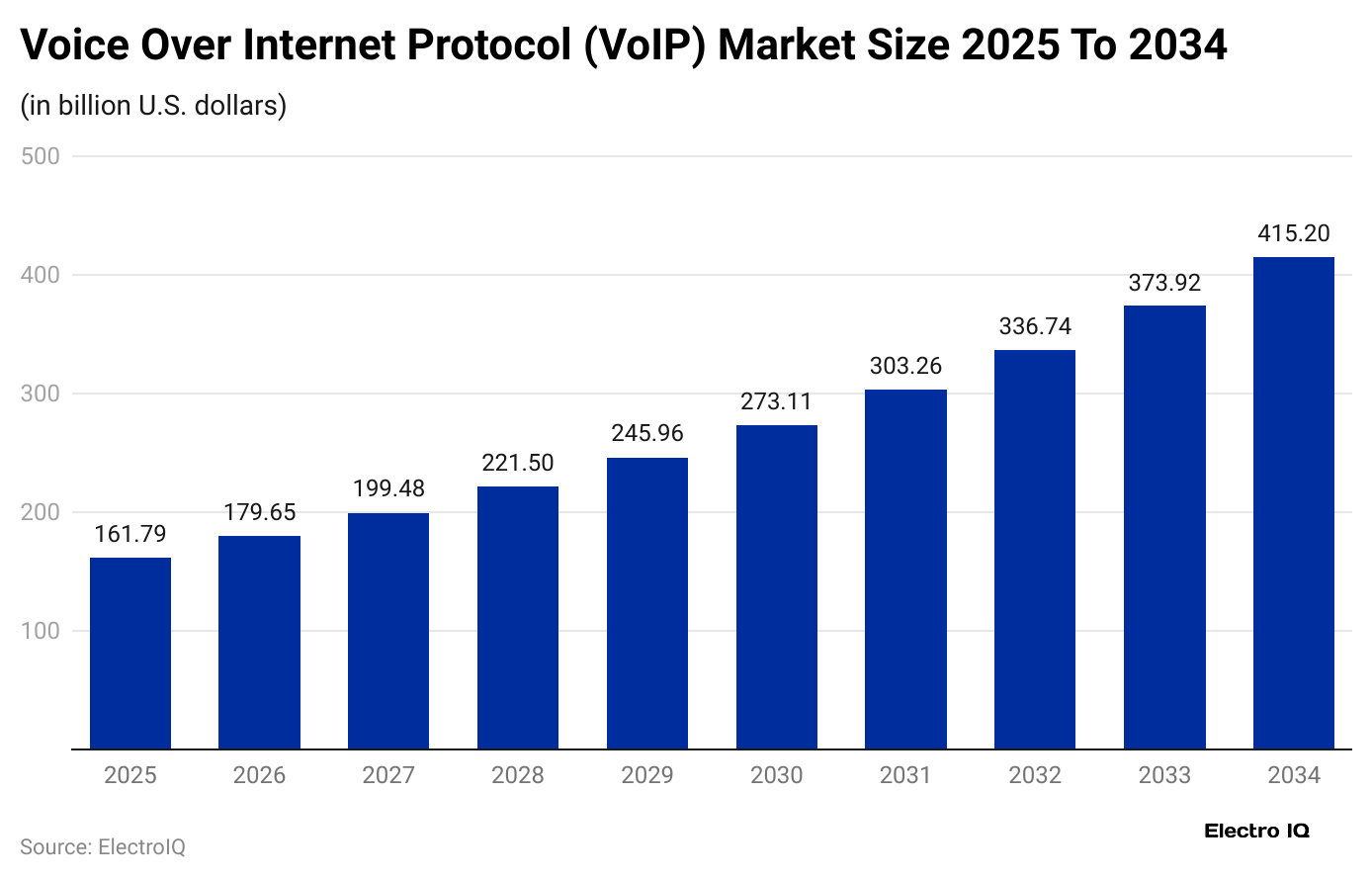
- The above graphical analysis shows that by the end of 2025, the VoIP market will reach around USD 161.79 billion and is estimated to grow to USD 415.20 billion by 2034.
- The global market could grow at a steady rate of 11.04% CAGR between 2025 and 2034.
- Furthermore, estimated market size in coming years are stated as 2026 (USD 179.65 billion), 2027 (USD 199.48 billion), 2028 (USD 221.50 billion), 2029 (USD 245.96 billion), 2030 (USD 273.11 billion), 2031 (USD 303.26 billion), 2032 (USD 336.26 billion), and 2033 (USD 373. 92 billion).
- In 2024, North America led the VoIP industry, earning 48% of total revenue.
- Meanwhile, SIP trunking services generated the biggest portion, contributing 46% of the overall market earnings.
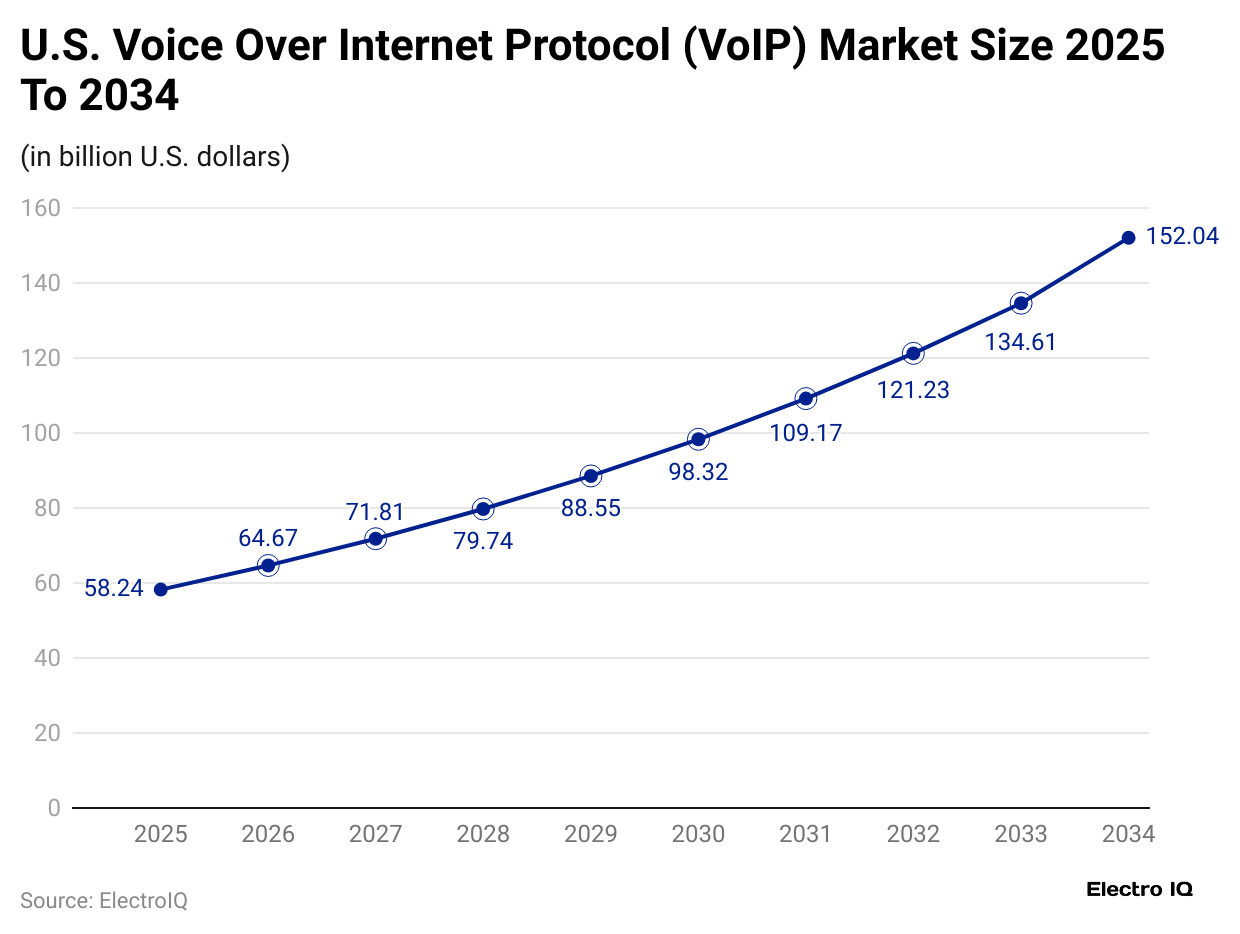
- As per Precedence Research, the United States VoIP market accounted for USD 52.45 billion in 2024 and is estimated to reach almost USD 152.04 billion by 2034.
- The overall market will grow at a CAGR of 11.22%, from 2025 to 2034.
- It further states that International VoIP calling makes up 58.5% of usage.
- Computer-to-computer setups lead with 46.6%, while SIP trunking holds 32.2%.
- Corporate users strongly rely on VoIP, contributing 78.7% of total use across all service and connection types.
VoIP User Statistics
- A report published by sci-tech-today.com states that in 2024, more than 3 billion people were using VoIP globally.
- In 2024, Asia-Pacific had 1.3 billion VoIP users, North America 830 million, and Europe around 590 million.
- Wi-FiTalents also states that in 2023, over 1.8 billion people around the world were using VoIP services.
- In 2024, mobile VoIP users are expected to exceed 2.5 billion, with 1.17 billion residential users and 1.93 billion business users worldwide.
- Small and medium-sized businesses account for more than 45% of all VoIP customers.
- About 60% of VoIP users now choose cloud-based systems instead of old landlines.
- Features like call forwarding and voicemail-to-email help users work better, boosting productivity by around 18%.
- Zippo reports that for choosing a VoIP provider, almost 85% of users prefer voice quality over other features.
Mobile VoIP Market Statistics by Region
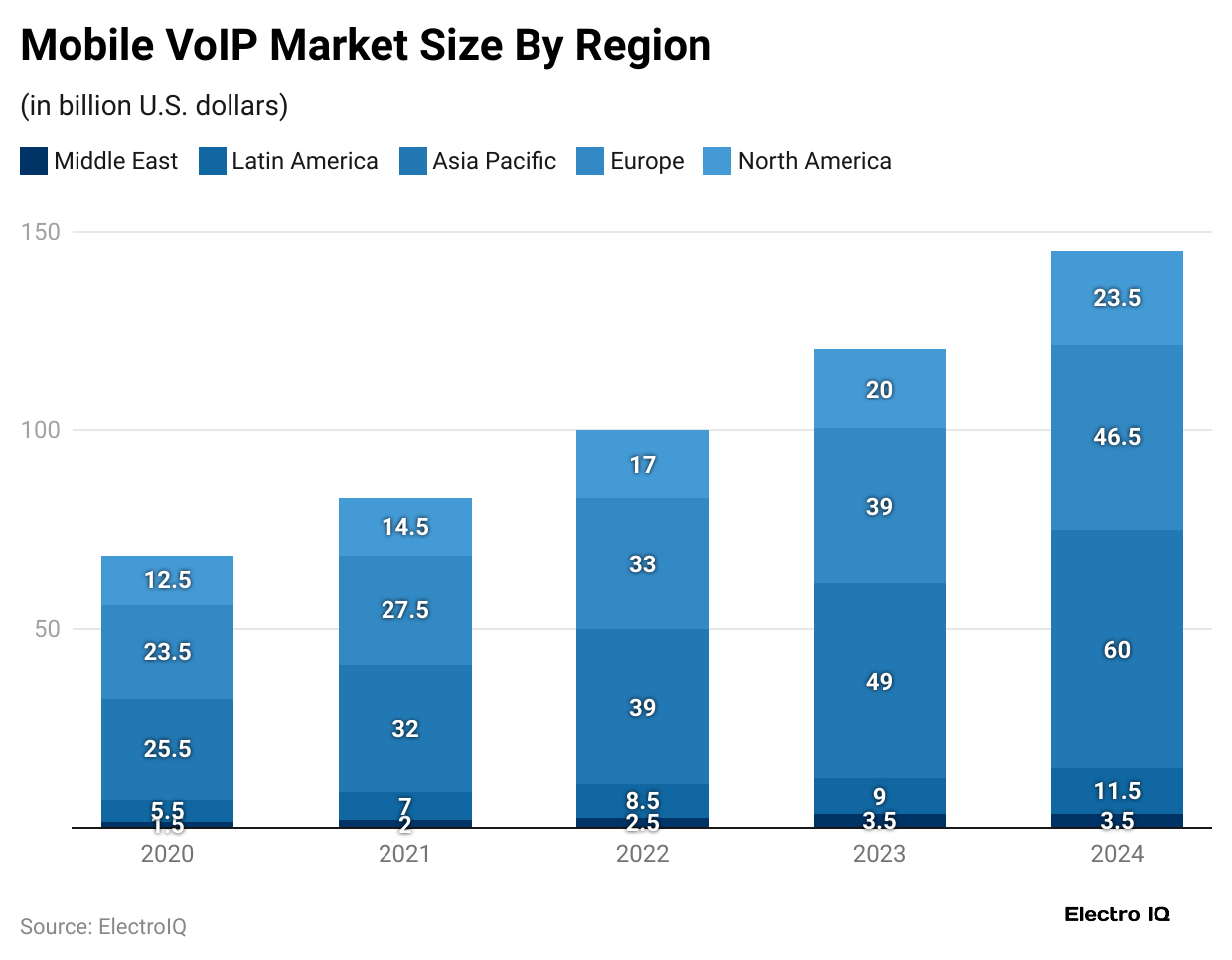
- As mentioned in the above graphical analysis, in 2024, the VoIP market in Asia Pacific is expected to reach USD 60 billion.
- Europe’s VoIP market size is projected to hit USD 46.5 billion in the same year.
- The market in North America may touch USD 23.5 billion, while Latin America could reach USD 11.5 billion.
VoIP Calls Statistics by Type
| Device Type | Calls Share | Growth Rate |
| Mobile Devices (Smartphones and Tablets) | 55% |
+12.5% (2020 to 2024) |
|
Desktops and Laptops |
30% | +8.3% per year |
| IP Phones | 12% |
-5% annually |
|
Other Devices |
3% |
– |
VoIP Usage Statistics
- In the U.S., over one-third of workers who can do their jobs remotely now work fully from home, while about 41% work remotely at least part of the time, according to Pew Research Center.
- Around 64% of companies have adopted a hybrid work model, as per Zoom.
- Many business leaders claimed that better productivity is the main reason they’re changing how people work.
- VoIP Statistics show that around 41% of leaders think offices will become more flexible soon.
- Over 75% of companies now offer support beyond regular working hours.
VoIP Statistics by Cost, Features, and Customer Experience
- wifitalents.com also depicts that business VoIP systems are helping companies cut telecom costs by up to 30% every year.
- As of 2024, customer service through VoIP increased customer satisfaction by 15% to 20%.
- Over the last five years, the average price per user for VoIP services has reduced by about 40%.
- Due to cloud technology advancements, the time taken to set up VoIP systems is now 25% shorter.
- For small businesses, monthly VoIP bills have fallen from USD 250 to USD 150 in the last 3 years.
VoIP Business Adoption Statistics
- According to the Zipdo report analysis, globally, more than 60% of companies use VoIP for their business communication needs.
- Approximately 78% of small businesses in the U.S. use VoIP phone systems.
- VoIP Statistics also shows that around 70% of large enterprises use VoIP solutions for their internal communication.
- Around 65% of people using VoIP say it helps them work better with their team.
- On average, users spend nearly 2 hours each week making business calls.
- More than 80% of VoIP companies also include CRM and analytics tools to improve customer communication.
- Many industries like IT, healthcare, finance, retail, and education now use VoIP to make their work faster and easier.
VoIP Security and Compliance Statistics
- According to the Zoom Blog, in 2024, the average cost of a data breach rose to USD 4.88 million, increasing by 10% in 2023.
- Cloud storage isn’t always safe, as 40% of breaches happened across systems, with public cloud attacks costing around USD 5.17 million.
- Around 29% of companies faced serious cyberattacks last year, and third parties caused 41% of those.
- In contrast, VoIP services faced growing threats, especially DDoS attacks, which more than doubled.
- Using AI and automation helped companies save almost USD 2.22 million on breach costs.
VoIP Website Traffic Statistics
- Voip-info.org is a niche-focused website dedicated to VoIP technology, attracting around 48.8K monthly visits as of May 2025.
- In the same duration, the traffic is primarily driven by organic search (50.6%) and direct visits (37%).
- The majority of users come from the United States (20.2%), followed by Russia, Brazil, Germany, and Mexico.
- VoIP Statistics further estimated that engagement metrics show a 41.5% bounce rate.
- In contrast, an average of 2.03 pages per visit, and a session duration of approximately 39 seconds.
- Compared to similar platforms like voipvoip.com (20.6K visits), asteriskguru.com (8K), and asteriskdocs.org (5.5K), voip-info.org leads in traffic volume.
- However, traffic declined by 7.1% from the previous month, indicating some performance instability.
Top 10 VoIP Service Providers Statistics, 2025
| Providers Name | Pricings (USD) | Best for | Features |
| GoTo Webinar | 49/organiser/month | Events | Interactive, engagement tools, and robust analytics. |
| Ooma | Ooma Office Essentials: 19.95/user/month | Ease of use | Call forwarding, voicemail-to-email, and call recording. |
| Vonage | Mobile: 13.99/month/line | Versatility | Auto-attendant, call routing, and advanced analytics. |
| RingCentral | Core: 9.99/user/month | Large teams | Team messaging and file sharing. |
| Nextiva | Core: 30/user/month | Customer service | Call analytics and CRM integration. |
| Dialpad | Standard:15/user/month | Scalability | Call transcription and sentiment analysis. |
| 8×8 | Custom pricing | Affordability | Advanced analytics and reporting. |
| Intermedia Unite | Unite Pro: 27.99/user/month | Third-party integrations | Email hosting and call analytics. |
| Grasshopper | True Solo: 14/month | Small businesses | 24/7 support |
| Google Voice | Free | Free VoIP solution | Call forwarding and voicemail transcription. |
Pros and Cons of VoIP
| Pros | Cons |
|
|
Conclusion
After completing the article on VoIP Statistics, it can be concluded that VoIP lets people make voice calls over the Internet instead of regular phone lines. It’s affordable, flexible, and supports extra features like video calling, file sharing, and group conferencing, making communication easier and smarter.
As internet connectivity improves globally, VoIP adoption continues to grow among individuals and businesses alike. With benefits like video conferencing, file sharing, and scalability, VoIP not only reduces communication costs but also enhances productivity and collaboration. Go through the overall report, and all the information will guide you effectively in understanding the topic better.
Sources
FAQ.
No, it’s not possible to run VoIP without an internet connection.
The two main types of VoIP are softphones and hard phones.
VoIP phones perform best with wired internet, but can also function over a wireless connection when needed.
VoIP systems usually stop working during power outages unless there’s a backup power source like a battery or generator.
VoIP uses internet-based technologies like IP networks, SIP (Session Initiation Protocol), and RTP (Real-Time Transport Protocol) to transmit voice data digitally.

Maitrayee Dey has a background in Electrical Engineering and has worked in various technical roles before transitioning to writing. Specializing in technology and Artificial Intelligence, she has served as an Academic Research Analyst and Freelance Writer, particularly focusing on education and healthcare in Australia. Maitrayee's lifelong passions for writing and painting led her to pursue a full-time writing career. She is also the creator of a cooking YouTube channel, where she shares her culinary adventures. At Smartphone Thoughts, Maitrayee brings her expertise in technology to provide in-depth smartphone reviews and app-related statistics, making complex topics easy to understand for all readers.

